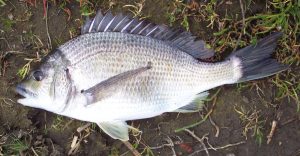Currently Empty: $0.00

If you’re fishing the Atlantic, especially near reefs, wrecks, or rocky bottoms, you’ve probably hooked into a porgy fish whether you meant to or not. Porgy, or “scup” as they’re called in the Northeast, are one of those steady, dependable catches. They’re not glamorous, they’re not monsters, but they bite, they fight, and they taste great. That’s enough for most honest fishermen.
In this article, I’ll break down where to find porgy, what tackle works best, how they behave, and why they’re worth keeping. I’ve fished porgies for years off boats and piers alike, and if you know what you’re doing, they can fill a cooler fast.
What is a Porgy Fish?
Porgies are a group of fish in the Sparidae family. The most commonly caught in the U.S. is the Northern Porgy or Stenotomus chrysops. They’re schooling bottom feeders, usually silver with a bit of iridescent shine and a round body. Not flashy, but functional.
- Common names: Porgy, scup
- Average size: 1 to 2 pounds, though larger ones can hit 3+ pounds
- Habitat: Inshore waters, wrecks, reefs, hard bottoms
- Best depth: 10 to 100 feet depending on season
They’re widespread from the Carolinas up to Massachusetts and even into the Gulf in some areas. Most of the serious porgy fishing happens from spring to early fall.
Best Gear for Porgy Fishing
They’re not hard to catch, but you need the right gear to avoid losing fish or getting robbed by their quick pecks. Their mouths are small, but strong. They nibble first, then strike if the bait seems right.
- Rod: Light to medium spinning or conventional setup
- Line: 10–20 lb monofilament or braid
- Hooks: Small, sharp hooks, size 1 to 2/0
- Weights: Just enough to hold bottom in current, typically 2 to 6 oz
Keep it simple. I usually use a two-hook dropper rig with clam, squid strips, or sandworms. If you’re getting robbed without hookups, switch to smaller hooks or shorter pieces of bait.
Where and When to Target Porgy Fish
Porgies stick to structure. If you’re drifting over sand or mud, you’re wasting your time. Look for hard bottom, rock piles, reef edges, and wrecks. They hold tight to these areas, and once you find them, you can stay on fish all day.
- Best time of year: May through October, depending on location
- Time of day: Early morning and late afternoon are best
- Best structure: Reefs, wrecks, jetties, underwater rock piles
- Boat or shore: Both work, but boats give you better access
Chumming helps. If you’re anchored up and want to keep the school interested, toss over some crushed clam or fish bits.
How Do They Fight?
For their size, porgies put up a good scrap. Once they’re hooked, they shake hard and dive for cover. You’ll feel every twitch. They’re fast, and if you give them slack or mess up your timing, they’ll pop off.
They don’t have the strength of a striper or the wild run of a bluefish, but they’re not boring. Especially when you’re pulling up doubles from 80 feet down with steady action.
Can You Eat Porgy?
Yes, and if you’ve never eaten it, you’re missing out. It’s a firm, mild white meat, great for frying, baking, or grilling. Just know it’s a bit bony. If you’re not into picking through bones, stick with fillets. That said, a whole grilled porgy with garlic and lemon? That’s solid eating.
Nutritional Info (per 100g cooked)
| Nutrient | Amount |
|---|---|
| Calories | 105 |
| Protein | 20g |
| Total Fat | 2.5g |
| Omega-3 | 280mg |
| Sodium | 65mg |
Great for low-fat diets or anyone looking for a clean-tasting fish. If you’re fishing for food, porgy delivers both quantity and quality.
Tips to Catch More Porgies
After years fishing them on boats and from docks, these are the tips that actually make a difference:
- Use fresh bait: Porgies are picky about scent and texture
- Feel the nibble: Don’t yank on the first tap — let them take it
- Stay on the bottom: They rarely hit mid-water
- Sharpen your hooks: Their mouths are tough, so you need a sharp point
- Move if it’s slow: If you’re not getting bites in 15 minutes, change location
Final Thoughts
Porgy fish aren’t trophy fish, but they’re reliable, accessible, and good eating. They’re a great fish for beginners to learn with and a steady favorite for experienced anglers who just want to catch a bunch and enjoy the day. No tricks, no gimmicks, just consistent bites and a cooler full of fillets if you do it right.
Whether you’re dropping bait from a boat or casting off a rocky jetty, porgy fishing is something every saltwater angler should experience. It’s not glamorous, but it’s honest fishing — and there’s nothing wrong with that.


